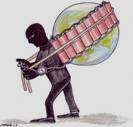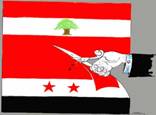|
Kamran Mir Hazar
Letter to Editor
Abdali: Figure of
Controversy

By: Soraab Balkhi
Like other countries, Afghanistan has
always had its share of controversial figures. However, people
have constantly distorted history to shape those figures into
what they wish them to be. Ahmad Shah Abdali is one such figure
whose actions were not carefully scrutinized by those of his own
ethnicity. The Pashtuns have bestowed on him unwarranted honor
and value at the expense of the lives of his victims which
consists of the people of Afghanistan , Pakistan and Indian
which includes Muslims, Hindus and Sikhs. To the rest of the
world, his actions convey the fact that he was nothing more than
a looting, barbaric criminal.
Ahmad Khan, born in today's Multan of Pakistan, was the son of
Zaman Khan, hereditary chief of the Abdali tribe. Zaman Khan
took Ahmad Khan and his family to Kandahar where most of the
people were of the Ghilzai tribe. There was major animosity
between the two tribes that Zaman Khan and his family were
consequently jailed by the Ghilzais. Then, Nadir Shah invaded
Kandahar and fought with the Ghilzais. He figured the Abdali
tribe to be his allies, considering the enemy of his enemy to be
his friends. He released the Abdali prisoners from jail and
took a lot of boys with him, including Ahmad Khan whom he
considered to be one of the prettiest boys. After being rescued
by Nadir Shah in 1738, Ahmad Khan consequently fell into his
services. Nadir Shah was known to be a child molester and it
was no surprise that he took 12-year old Ahmad Khan under his
wing and the two had a very close physical relationship. He
gave Ahmad Khan command over a group of Abdali tribesmen. Nadir
Shah had many servants but Ahmad Khan was favored above the rest
because of his young, handsome features. All the servants of
Nadir Shah wore pearl earrings, a feminine touch that he was
very fond of. He gave Ahmad Khan the title "Dur e Durrani"
(Pearl of Pearls) and which would later on lead Ahmad Khan into
changing the Abdali tribe name to the Durrani tribe.
After Nadir Shah's assassination in 1747 things became a bit
chaotic: Nadir Shah's generals starting fighting amongst
themselves, rumors circulated that they might have had been
involved in the assassination; Ahmad Khan didn't want to take
part of the conflict and he chose the easy way out and took
Nadir Shah's treasures and went to the region of Kandahar where
there was essentially a power vacuum. In Kandahar, there was
tension between the Pashtuns and they couldn't stop their
fighting. They adamantly wanted to find a commonality to bind
them together and looked for common leadership but couldn't
agree on a person. Saber Shah, a spiritual leader from today's
Lahore who used to live in Kabul, was present during the tribal
meetings in Kandahar. The tribal leaders asked him to make the
decision in choosing from the number of possible leaders. Saber
Shah knew that the region was in conflict and there weren't many
good choices among the various people. The only possibility for
him was Ahmad Khan because Ahmad Khan had Nadir Shah's treasures
along with a trained army under his command. And most
importantly, Ahmad Khan was an outsider and he had no claim in
local problems. So despite his young age and rumors of his
being involved in Nadir Shah's assassination, Ahmad Shah became
that leader for those tribes of Pashtuns and he was no longer
known as Ahmad Khan but as Ahmad Shah. Led by Ahmad Shah, the
tribes violently seized richer revenue-producing areas such as
Kabul, Herat, Punjab, Kashmir, and Turkistan.
These actions exemplify the fact that
to declare him as the king or founder of Afghanistan is
condemnable. Ahmad Shah was the first Pashtun ruler of that
region but he was not the founder of Afghanistan because there
was Khorasan during his time, not Afghanistan. Most of the
history claiming Ahmad Shah as the founder of Afghanistan was
produced in the past half century. It was in the ruling class
of Pashtuns’ interest to claim Ahmad Shah was the founder of
Afghanistan. Monshi Mahmud Al Hussien Al Monshi Ben Ibrahim Al
Jami was the official historian of Ahmad Shah’s court. Under
Ahmad Shah’s supervision, Monshi Mahmud wrote “Tareekhi Ahmad
Shahi” (Ahmad Shahi History), an important two volume account of
history written in Farsi. Most likely Ahmad Shah went over
every single sentence of each of the volumes to make sure it was
exactly as he wanted it to be because he knew they were to go
down as historical texts. So it is evident which books would be
more valid and accurate, it is more reasonable to use Ahmad
Shah’s own words than someone’s fabricated lies written two
centuries later. And in Ahmad Shah’s historical books, there is
not even one mention of ‘Afghanistan.’ If Ahmad Shah was the
king of Afghanistan, there is no doubt that he would have used
the name ‘Afghanistan’ and would have included it in his account
of history. Afghanistan was purely a British invention which
came about during Yaqub Khan’s reign. The Gandomak Treaty which
he signed with Britain in 1879 was the first document to mention
the name ‘Afghanistan’ or ‘Afghanland.’ Before 1879, every ruler
of the region, including Abdali, had referred themselves as the
Amirs and rulers of Khorasan. So Ahmad Shah was solely for the
Pashtun tribes and had virtually nothing to do with the non-Pashtuns,
except for oppressing them, stealing their land, etc. He held
the title of "King of the Afghans" not "King of Afghanistan"
because at that time, "Afghanistan" did not indicate a state but
instead territories.
And so, Ahmad Shah's reign of terror began. With his newfound
powers, Ahmad Shah seized the opportunity to make his mark. He
captured Ghazni from the Ghilzai Pashtuns and then Kabul from
the local ruler. He forced himself upon those areas, moving in
like a parasite would and depleting the regions. His invasions
brought forth waves of chaos and havoc. The people of Ghazni
and Kabul—and later on Herat as well as other
regions—desperately fought back as they did during the invasions
of Changiz Khan. For those people, there was no difference
between the atrocities committed by Changiz Khan and those
committed by Ahmad Shah about six centuries later. He murdered
innocent women and children, destroyed families and homes, and
stole everything in sight because he had no honor. Human life
meant nothing to him as he left piles of dead bodies in his
wake. In a civilized society, a criminal like Ahmad Shah would
have been punished for his crimes. Instead, the Pashtuns bestow
a twisted tribute to him, celebrating his inhumanness and taking
pride in his barbaric, animalistic behavior. People became
destitute, were killed, and unnecessarily suffered greatly
because of his greed and cruel behavior and these actions are
respected and admired by many Pashtuns today.
He invaded Khorasan and ransacked the Persian treasures, making
his own crown with the stolen "Koh e Noor." Maintaining
leadership of various Afghan tribes meant that one has to keep
the tribes busy and satisfied. Therefore, Ahmad Shah took his
fellow barbarians continuously into India to raid and loot,
telling them to take whatever and everything they can get their
hands on. In 1748, he first crossed the Indus River to take
modern-day Lahore which was Hindustan at that time. In 1749, in
order for the Mughul ruler to prevent his capital from being
attacked by Ahmad Shah, he was forced to relinquish Sindh and
all of Punjab west of the Indus River to the invader. In 1751,
he invaded Lahore once more and looted the city from top to
bottom, leaving almost nothing left. Apart from invading
Punjab three times from 1747-1753, Ahmad Shah also captured
Herat in 1750 after almost a year of bloody conflict and seized
both Nishpar and Meshad in 1751. To this day, the people of
North India, Panjub, and Sindh of Pakistan which include Muslim,
Hindu and Sikhs associate the name Abdali with the Devil. Ahmad
Shah and his tribesmen tortured, killed, looted, and raped the
people of today's Eastern Iran, Pakistan, Afghanistan and
Northern India. They took back their booty to Kandahar and
enjoyed their stolen goods. In the course of his criminal
career, he raided India nine times, stealing the valuable
treasures of the Mughul Empire and everything else he could get
his hands on. His raids would last for days with unending
turmoil; nobody was left with clothes to wear or food to eat;
many died from inflicted wounds or even by committing suicide
while others suffered in the harsh climates because they had
lost their homes. Their livelihood, their grains, their
possessions were taken by the looters and sold back to them at
exorbitant prices.
Aside from monetary possession, he was also fond of possessing
women. In 1756/57 Ahmad Shah sacked Delhi during his fourth
invasion of India and burgled every corner of the city. He
arranged marriages for himself and his son, Timor, into the
Imperial family. Ahmad Shah had many wives to begin with but
he just couldn't resist adding the princess from the Imperial
family into his collection. Despite her being royalty, he
treated her the same way he treated his other wives and his
daughters. He had no respect for anybody and only way he
received respect was through leading looting sprees for his
tribesman, encouraging them to steal as much as they could from
India and taking any woman they desired. His gang of
barbarians would dig up people's houses to find hidden
treasures, leaving the residents homeless and despaired.
Torture and beating were common practices to extort his booty
which consisted of jewels, diamonds, ornaments, etc. Leaving
Timor behind to be in charged, Abdali then left India to return
to Kandahar. On his way back, he couldn't resist attacking the
Golden Temple in Amristar and filled its sarovar (sacred pool)
with the blood of slaughtered cows and people. The Golden
Temple is to the Sikhs what Mecca is to the Muslims so his
transgressions were of great proportions. Now, what kind of
honorable man would commit such an atrocious act? He had no
reason to attack the Golden Temple but did it purely because of
the evilness that ran in his blood. He knew that cows were
considered sacred by the Sikhs but he disregarded their beliefs
and their values. How can such a person stand for a model for
the non-Pashtuns of Afghanistan?
The Marathas were the native Indians who fought against
foreign invaders, as would any group who had to suffer through
torture from foreigners. When the Maratha chiefs declared war
on Ahmad Shah, he took this as an opportunity to cross the Indus
again and attack them, setting their villages on fire. In
1758, the Marathas gained possession of Punjab, but the victory
was short-lived. On January 6, 1761, they lost to Ahmad Shah in
the great battle of Panipat. It was a tortuous time for the
inhabitants of the region. The plunder and the savage
slaughtering began once more. Ahmad Shah's tribes went home to
home, breaking down doors, capturing those inside and burning
them alive or cutting off their heads. There was bloodshed and
destruction everywhere and nothing and no one was spared. Men
of high esteem were disintegrated into nothing, noblemen were
left destitute, men's wives and children were made captive
and/or killed. In a later raid, Ahmad Shah inflected a severe
defeat upon the Sikhs but had to immediately head westward back
to Kandahar to quell a rising insurrection. Meanwhile, the
Sikhs rose again in power and Ahmad Shah was forced to abandon
his hopes of retaining the command over the Punjab.
Over the course of 25 years, he weakened India and its Raj and
local government. He ventured into India numerous times and
each time, he returned with gold, camels, women, etc. He left a
great number of people dead, destroyed cities and lives and
families. All of this seemed like fun to him and his people.
Therefore, when he died in 1773, his descendants began fighting
over the throne. The British took this moment of weakness to
step in and create more division. Abdali's sons were busy
fighting against and killing each other and the British aided
the brothers in staying enemies and gradually they weakened the
state and took over. It is because of Ahmad Shah and his gang
of marauders who crushed the indigenous people of the
regions—the Marathas and the Mughuls—that the entire
subcontinent of India including today's Afghanistan was
colonized by the British for the 19th century and well into the
20 th century.
This led to the creation of modern-day Afghanistan. Since
then, the non-Pashtuns of Afghanistan have had to deal with
these treacherous and corrupt Pashtuns who have occupied our
land. Most Pashtuns impose Abdali the Father of the Nation.
But why should we, the Tajiks, Hazaras, Uzbeks, etc. accept that
title and claim? Abdali is not the Father of our Nation. He
was an untrustworthy opportunist, an invader who raided and
destroyed our land. We are still left to deal with the
remaining savage descendants of Abdali such the Taliban and
Mellatis. The Father of our Nation is Saman Khuda, the man who
wrestled our land back from the Arabs and established a
civilized and prosperous land. Ahmad Shah Abdali was the enemy
of our nation, the destroyer of our nation. For non-Pashtuns
to celebrate and honor Abdali would be treason.
Abdali symbolizes what it means to be an "Afghan." It doesn't
matter if the definition of the word Afghan is changed to fit
the modern-day needs. The fact is the connotations behind
Afghan are one that signifies a looter, criminal, barbaric
murderer. He had to prove his leadership qualities by destroyed
the homes and lives of other people. He knew he had no control
over his own tribesman and the only way to obtain control was to
send them on horrific raids into India. These actions
illustrate that Abdali and his Pashtun tribes were nothing more
than a pack of wild, uncivilized animals that were only brought
together by their uncontrollable primal needs.
References:
-
Monshi Mahmud Al Hussien Al
Monshi Ben Ibrahim Al Jami. Tareekh Ahmad Shahi
Volume 1 and 2.
-
Caroe, Olaf. The Pathans.
-
Alqawi, Mirza Mohammed Yaqob. Yadasht hay dar Bari
Afghanistan.
-
Kashani, Abul Hussain Ghafari. Gulshan ul Morad, Tareekh
Zayed.
-
Nafsi, Sayeed. Tareekh Ijtemai wa Syasi Iran Dawrahi
Mahasir. Vol. 1&2.
-
Gandom, Pori Shir Mohammed. Tareekh Khorshidi Jahan Sana
1311 Hejri.
-
Mahmud, Mahmud. Tareekh Rawabiti Syasi
Iran va Englis.
-
Panipat ki akhiri jang (Unknown Binding) by Kashi Raj
-
Marathas : Rise and Fall B R Verma and S R Bakshi
-
Ali, Mubarak. “Yes, he did massacre and plunder Indians.”
Dawn. August 30, 2003.
-
Singh, Daljeet and Kharak Singh. “Ahmad Shah Abdali’s
Invasions.” Sikhism, it’s philosophy and history.
-
Singh, Sirdar Kapur. “The Golden Temple: Its Theo-political
Status.”
|
|
Letter to Editor
Go back to
Index |
|
|
Domain Registration |
|
Web
Design |
|
Web
Hosting |
|
MG
Strong: 5000 |
|
Email: 2500 |
|
 |
|
My
SQL/ CGI.BIN |
|
 |
|
 |
|
Data Transfer: 150GB |
|
Contact: 0093799390025 |
I really enjoyed reading Kabul
Press on line. Great work. I would like to submit a
paper for your consideration. I hope you find it worthy
of publishing in Kabul Press.
|
|






